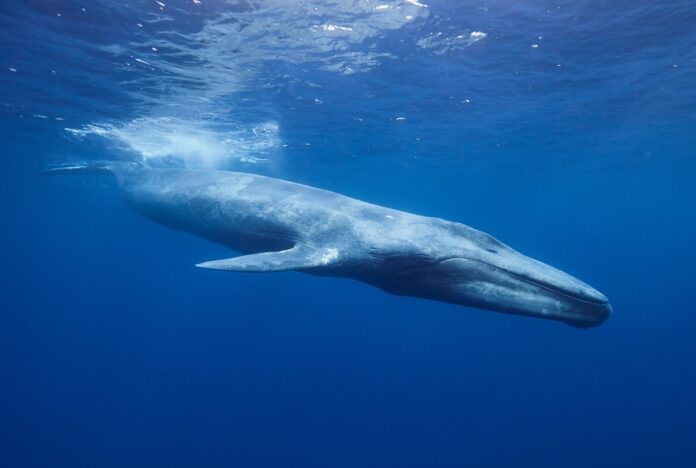The blue whale is renowned as the Earth’s largest animal, taking that title today by quite some distance. That holds true even stretching back through time as these enormous marine mammals are even bigger than some of the largest of the dinosaurs.
How Big Is a Blue Whale?
(Credit: Ajit S N/Shutterstock)
The largest blue whale ever found stretched 33 meters (108 feet) and was caught by whalers in the early 1900s. Usually, however, they can range between 24 and 30 meters (78-98 feet) in length, depending on where they live. Some of the largest reside in the Antarctic.
Their mouths are so large they can gulp down as much as 80,000 liters (~21,000 gallons) of water in one go. To pump blood around their massive bodies, blue whales also have a massive heart that is 1.5 meters wide by 1.5 meters high (5 feet wide and 5 feet high), weighing around 1360 kilograms (~3000 pounds). When it comes to their flippers, however, blue whales’ are relatively short for their body size at around 3 to 4 meters (9 to 13 feet) in length. The humpback whale, for instance, has flippers that are around five meters long, or nearly a third of their body length.
Blue whales also give birth to enormous calves, the largest in the animal kingdom. They are usually between 6 to 8 meters (19 to 26 feet) in length and can weigh as much as 3.5 tonnes, not far off that of a fully grown female Asian elephant. To feed their infant, the mother produces more than 190 liters (~50 gallons) of nutrient-rich milk each day.
Read More: 5 Of The Biggest Animals To Ever Live On Earth
How Much Does a Blue Whale Weigh?
The largest blue whale weighed an incredible 190 tonnes. On average, however, they’ll weigh as much as 135 tonnes and as “little” as 72 tonnes. By contrast, the African elephant – the world’s heaviest terrestrial animal – tips the scale at a comparatively meagre 6.6 tonnes.
Even though they are the largest creatures on the planet, blue whales sustain themselves on a tiny shrimp-like creature called krill. To nourish their enormous bodies, blue whales eat as much as 10 to 20 tons of krill per day, which can come to around 12 percent of their body weight. With every single mouthful, they can consume as much as 457,000 calories, the amount an average human would need over the span of around 228 days.
Read More: Blue Whales Chase the Wind to Hunt Tiny Prey
Where Do Blue Whales Live?
(Credit: Andrea Izzotti/Shutterstock)
Blue whale populations are widely distributed throughout the world’s oceans. They live in all oceans except for the Arctic. Though data on their movement is often sparse, they will generally migrate long distances between feeding grounds and breeding grounds, depending on the season.
Populations in the North Pacific Ocean, for example, will spend the summer months in the Gulf of Alaska before moving on to warmer waters near Mexico and Central America. However, not all populations migrate. One such “resident” population lives near Sri Lanka in the Northern Indian Ocean.
Read More: 4 Ways Whales Show They are Highly Intelligent Creatures
Are Blue Whales Endangered?
There are estimated to be 10,000 to 25,000 blue whales in the world. Those numbers are considered a fraction of their past population before rampant whaling decimated their numbers in the 19th and 20th centuries. Before whaling commenced, there may have been as many as 225,000 blue whales living in the Southern Hemisphere alone.
It’s thought that populations living in the Antarctic and North Atlantic may have dropped to the low hundreds in the 1960s and 70s, around the time commercial whaling ended. There are hopeful signs that some populations, such as those in the Southern Ocean, may be increasing, albeit slowly.
Today, blue whales are still endangered and face a number of threats, though whaling is now broadly banned across the globe. Ship strikes are considered one such threat, as large vessels can severely injure or even kill a blue whale. Climate change, warming, and increasing ocean acidification could also dramatically impact their main source of prey in the future.
Read More: How Many Whales Are Left In the World?
Article Sources
Our writers at Discovermagazine.com use peer-reviewed studies and high-quality sources for our articles, and our editors review for scientific accuracy and editorial standards. Review the sources used below for this article:
Sean Mowbray is a freelance writer based in Scotland. He covers the environment, archaeology, and general science topics. His work has also appeared in outlets such as Mongabay, New Scientist, Hakai Magazine, Ancient History Magazine, and others.
Source : Discovermagazine
















